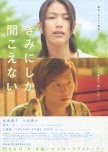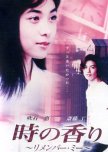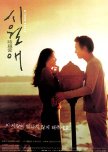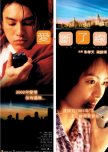

Directed by Hagishima Tatsuya, Kimi ni Shika Kikoenai (a.k.a. Calling You) is based on the same-titled light novel series by popular writer Otsuichi. Like Otsuichi's Waiting in the Dark, which was also recently adapted for the big screen, Kimi ni Shika Kikoenai revolves around two lonely young people who find each other in an uncommon manner. Shy, quiet, and unsure of herself, Aihara Ryo doesn't quite fit in anywhere. Though she wants to make friends, she has trouble speaking up and holding a normal conversation like everyone else. It seems that whenever she talks, the words just don't come out correctly. Gradually, Ryo has gotten used to living life in silence as a lonely and introverted student. With no one to talk to, Ryo also has no need for a cell phone. Longing for friends to talk to, she creates a cell phone in her mind for imaginary phone conversations, and much to her surprise, one day Shinya picks up on the other side. For the first time in her life, Ryo has found someone she can talk to.


Directed by Hagishima Tatsuya, Kimi ni Shika Kikoenai (a.k.a. Calling You) is based on the same-titled light novel series by popular writer Otsuichi. Like Otsuichi's Waiting in the Dark, which was also recently adapted for the big screen, Kimi ni Shika Kikoenai revolves around two lonely young people who find each other in an uncommon manner. Shy, quiet, and unsure of herself, Aihara Ryo doesn't quite fit in anywhere. Though she wants to make friends, she has trouble speaking up and holding a normal conversation like everyone else. It seems that whenever she talks, the words just don't come out correctly. Gradually, Ryo has gotten used to living life in silence as a lonely and introverted student. With no one to talk to, Ryo also has no need for a cell phone. Longing for friends to talk to, she creates a cell phone in her mind for imaginary phone conversations, and much to her surprise, one day Shinya picks up on the other side. For the first time in her life, Ryo has found someone she can talk to.


Directed by Hagishima Tatsuya, Kimi ni Shika Kikoenai (a.k.a. Calling You) is based on the same-titled light novel series by popular writer Otsuichi. Like Otsuichi's Waiting in the Dark, which was also recently adapted for the big screen, Kimi ni Shika Kikoenai revolves around two lonely young people who find each other in an uncommon manner. Shy, quiet, and unsure of herself, Aihara Ryo doesn't quite fit in anywhere. Though she wants to make friends, she has trouble speaking up and holding a normal conversation like everyone else. It seems that whenever she talks, the words just don't come out correctly. Gradually, Ryo has gotten used to living life in silence as a lonely and introverted student. With no one to talk to, Ryo also has no need for a cell phone. Longing for friends to talk to, she creates a cell phone in her mind for imaginary phone conversations, and much to her surprise, one day Shinya picks up on the other side. For the first time in her life, Ryo has found someone she can talk to.


Directed by Hagishima Tatsuya, Kimi ni Shika Kikoenai (a.k.a. Calling You) is based on the same-titled light novel series by popular writer Otsuichi. Like Otsuichi's Waiting in the Dark, which was also recently adapted for the big screen, Kimi ni Shika Kikoenai revolves around two lonely young people who find each other in an uncommon manner. Shy, quiet, and unsure of herself, Aihara Ryo doesn't quite fit in anywhere. Though she wants to make friends, she has trouble speaking up and holding a normal conversation like everyone else. It seems that whenever she talks, the words just don't come out correctly. Gradually, Ryo has gotten used to living life in silence as a lonely and introverted student. With no one to talk to, Ryo also has no need for a cell phone. Longing for friends to talk to, she creates a cell phone in her mind for imaginary phone conversations, and much to her surprise, one day Shinya picks up on the other side. For the first time in her life, Ryo has found someone she can talk to.


Directed by Hagishima Tatsuya, Kimi ni Shika Kikoenai (a.k.a. Calling You) is based on the same-titled light novel series by popular writer Otsuichi. Like Otsuichi's Waiting in the Dark, which was also recently adapted for the big screen, Kimi ni Shika Kikoenai revolves around two lonely young people who find each other in an uncommon manner. Shy, quiet, and unsure of herself, Aihara Ryo doesn't quite fit in anywhere. Though she wants to make friends, she has trouble speaking up and holding a normal conversation like everyone else. It seems that whenever she talks, the words just don't come out correctly. Gradually, Ryo has gotten used to living life in silence as a lonely and introverted student. With no one to talk to, Ryo also has no need for a cell phone. Longing for friends to talk to, she creates a cell phone in her mind for imaginary phone conversations, and much to her surprise, one day Shinya picks up on the other side. For the first time in her life, Ryo has found someone she can talk to.


Directed by Hagishima Tatsuya, Kimi ni Shika Kikoenai (a.k.a. Calling You) is based on the same-titled light novel series by popular writer Otsuichi. Like Otsuichi's Waiting in the Dark, which was also recently adapted for the big screen, Kimi ni Shika Kikoenai revolves around two lonely young people who find each other in an uncommon manner. Shy, quiet, and unsure of herself, Aihara Ryo doesn't quite fit in anywhere. Though she wants to make friends, she has trouble speaking up and holding a normal conversation like everyone else. It seems that whenever she talks, the words just don't come out correctly. Gradually, Ryo has gotten used to living life in silence as a lonely and introverted student. With no one to talk to, Ryo also has no need for a cell phone. Longing for friends to talk to, she creates a cell phone in her mind for imaginary phone conversations, and much to her surprise, one day Shinya picks up on the other side. For the first time in her life, Ryo has found someone she can talk to.


Produced and directed by Johnnie To and Wai Ka Fai, the film stars Takeshi Kaneshiro and Gigi Leung. The story is based on the book A Chance of Sunshine by Jimmy Liao, who makes a cameo appearance in the film. It is also the first Chinese-language Asian film ever from Warner Bros.
The original graphic novel is now sold under the name "Turn left, turn right" and consists of a series of detailed cartoon images, with a small amount of text in a diary style. The film has managed to include every single image in the book with a high level of accuracy, although some are fleeting.
Leung plays a translator, and Kaneshiro plays a violinist who lives parallel lives and appears to be perfect for each other, but somehow fate seems to keep them apart.
The original graphic novel is now sold under the name "Turn left, turn right" and consists of a series of detailed cartoon images, with a small amount of text in a diary style. The film has managed to include every single image in the book with a high level of accuracy, although some are fleeting.
Leung plays a translator, and Kaneshiro plays a violinist who lives parallel lives and appears to be perfect for each other, but somehow fate seems to keep them apart.


Produced and directed by Johnnie To and Wai Ka Fai, the film stars Takeshi Kaneshiro and Gigi Leung. The story is based on the book A Chance of Sunshine by Jimmy Liao, who makes a cameo appearance in the film. It is also the first Chinese-language Asian film ever from Warner Bros.
The original graphic novel is now sold under the name "Turn left, turn right" and consists of a series of detailed cartoon images, with a small amount of text in a diary style. The film has managed to include every single image in the book with a high level of accuracy, although some are fleeting.
Leung plays a translator, and Kaneshiro plays a violinist who lives parallel lives and appears to be perfect for each other, but somehow fate seems to keep them apart.
The original graphic novel is now sold under the name "Turn left, turn right" and consists of a series of detailed cartoon images, with a small amount of text in a diary style. The film has managed to include every single image in the book with a high level of accuracy, although some are fleeting.
Leung plays a translator, and Kaneshiro plays a violinist who lives parallel lives and appears to be perfect for each other, but somehow fate seems to keep them apart.


Produced and directed by Johnnie To and Wai Ka Fai, the film stars Takeshi Kaneshiro and Gigi Leung. The story is based on the book A Chance of Sunshine by Jimmy Liao, who makes a cameo appearance in the film. It is also the first Chinese-language Asian film ever from Warner Bros.
The original graphic novel is now sold under the name "Turn left, turn right" and consists of a series of detailed cartoon images, with a small amount of text in a diary style. The film has managed to include every single image in the book with a high level of accuracy, although some are fleeting.
Leung plays a translator, and Kaneshiro plays a violinist who lives parallel lives and appears to be perfect for each other, but somehow fate seems to keep them apart.
The original graphic novel is now sold under the name "Turn left, turn right" and consists of a series of detailed cartoon images, with a small amount of text in a diary style. The film has managed to include every single image in the book with a high level of accuracy, although some are fleeting.
Leung plays a translator, and Kaneshiro plays a violinist who lives parallel lives and appears to be perfect for each other, but somehow fate seems to keep them apart.


It all started when Takashi, a talented composer who could not write a love song ever since his girlfriend Rina left him suddenly, accidentally sent an incomplete piece of his latest work to Amane via email. Deeply touched by his music, Amane wrote back to him, without getting a reply. Amane continued writing to him, pouring out her thoughts. Only when she signed as "Teru Teru Bozu", did Takashi responded with a mail saying "WHO ARE YOU?", because what Rina left him as a farewell gift was a teru teru bozu!


'Ditto' focuses on a female university student from 1979 who begins talking via HAM radio with another student from her school. They hope to meet, but through a series of misunderstandings, she begins to realize that the other student lives in the year 2000. This bit of the supernatural serves as the foundation for an exchange between these two, who are separated by 20 years during which their culture has been transformed.


Remake of the Korean film Ditto about a college student in the past who falls in love with a boy from the future.



